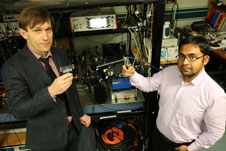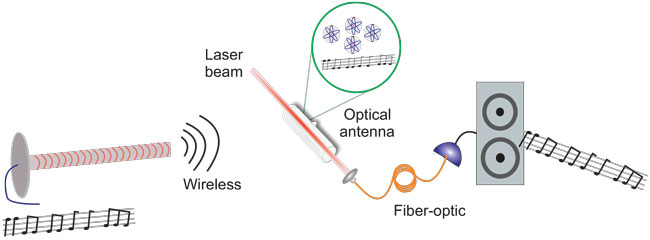 Tuesday 29 May 2018 12:29pm
Tuesday 29 May 2018 12:29pm

Associate Professor Niels Kjærgaard and Dr Amita Deb.
In the ongoing quest for better, faster and higher-quality wireless communication, University of Otago researchers are leading the way.
Dr Amita Deb and Associate Professor Niels Kjærgaard, of the Department of Physics, have created world-leading technology in the form of an optical antenna.
Their development, just published in acclaimed journal Applied Physics Letters, simplifies how we currently communicate wirelessly.
Dr Deb says the widespread use of smart phones and appliances have “fuelled an unprecedented demand for high bandwidth wireless networks”. The emerging 5G network will feature greater bandwidth, but its signal is prone to significant weakening and interference.
The optical antenna the Otago researchers have developed enables the transmission of high frequency signals, with the advantage of being non-metallic, and with no electrical connection required, mitigating the issue of interference.
“You can communicate information without electrical interference. Because this is optical – just laser light, no metal, no electronic connections – it is cleaner and clearer.
“Optical fibre cables can also transmit light hundreds of kilometres with very little loss,” Dr Deb says.
The technology interfaces wireless data with fibre optic data. It encodes a radio frequency signal within a laser beam – via an antenna in the mere form of a glass bulb filled with atomic particles – which can be transported via fibre-optic channels.
This would be like a radio station playing a song which is picked up by a laser beam, through a glass bulb, into an optical fibre. At the end of the fibre, light is detected and the song comes out of a speaker.

The new technology interfaces wireless data with fibre optic data. As illustrated here, it encodes a radio frequency signal within a laser beam – via an antenna in the mere form of a glass bulb filled with atomic particles – which can be transported via fibre-optic channels.
The work was funded by grants from the Marsden Fund and Otago Innovation Limited, with the next step being to increase the speed of the technology and reduce its size.
“The delivery of wireless data via optical fibre is a highly sought after technology in emerging high-speed technology applications and people in the industry have been really excited about this development,” Associate Professor Kjærgaard says.
He believes the optical antenna has military applications because it can't be wiped out via an electro-magnetic pulse, as well as in avionics. Miniaturised versions could also be used in biomedical settings such as electrophysiology, which measures the electrical activity of cells and tissues including the heart and brain.
For more information, contact:
Dr Amita Deb
Department of Physics
University of Otago
Tel 03 479 7677
Email amita.deb@otago.ac.nz
A list of Otago experts available for media comment is available elsewhere on this website.
Electronic addresses (including email accounts, instant messaging services, or telephone accounts) published on this page are for the sole purpose of contact with the individuals concerned, in their capacity as officers, employees or students of the University of Otago, or their respective organisation. Publication of any such electronic address is not to be taken as consent to receive unsolicited commercial electronic messages by the address holder.
